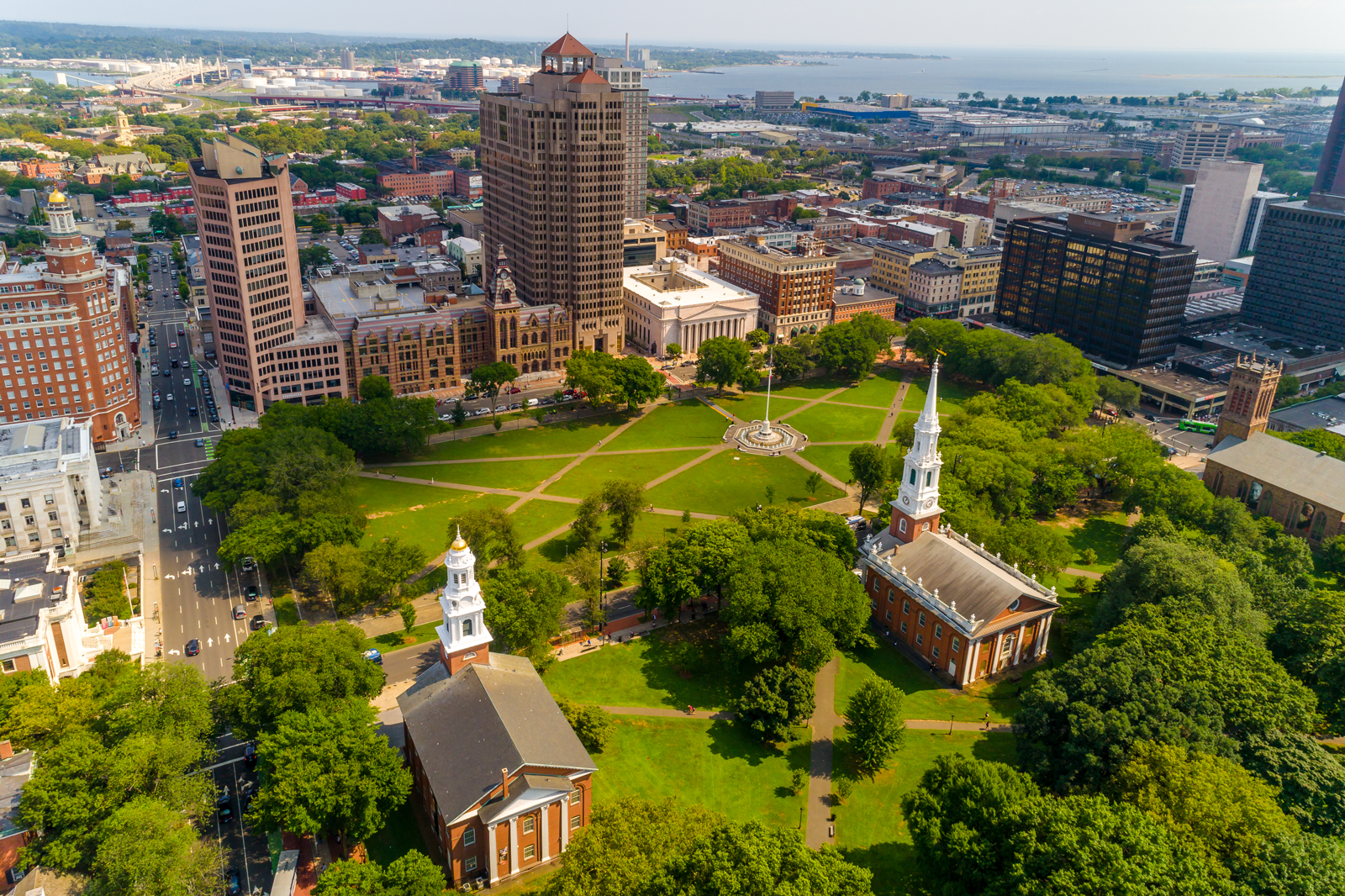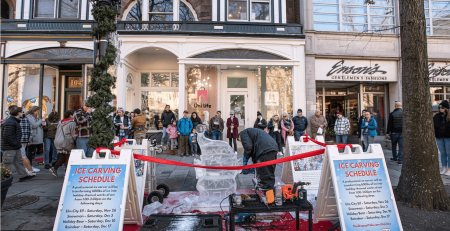What does it mean to be a thriving downtown district?
According to the International Downtown Association (IDA), the premier organization for urban place professionals who are shaping and activating dynamic city center districts, Downtown New Haven has been deemed an “established downtown,” a distinction we now share with such cities as Baltimore, Pittsburgh, Seattle, and Minneapolis.
Commissioned by Market New Haven, the New Haven Parking Authority and Town Green District, New Haven is the first city in New England to participate in IDA’s study, Value of U.S. Downtowns and Center Cities. The study was devised to provide a common set of metrics to communicate the value of downtowns based on more than 150 key data points across five core principles: economy, inclusion, vibrancy, identity, and resilience.
The study boundaries expanded on the City of New Haven’s definition of downtown to include New Haven Union Station and the Medical District to reflect the ‘Hill to Downtown’ plan, an ongoing effort designed to reconnect those neighborhoods to the traditional central business district, and better connect residents of those areas to the opportunities available downtown.
Here’s what we learned:
Downtown New Haven is the city’s economic engine.
Our downtown district is home to more than 10% of the city’s residents but 70% of its jobs. In contrast, other established downtowns like Pittsburgh and Baltimore have, on average just 43% city share of jobs. In New Haven, more than ⅔ of the city’s jobs are downtown. This is, in part, thanks to our proximity to Yale University, which educates and employs many New Haven residents. Primary employment growth in downtown grew 25% between 2002 and 2020, as compared to a -2% decrease in the larger region. Further, many downtown residents work where they live, with our share of live-work residents more than doubling since 2002.
On the small business front, our downtown district has significantly more storefronts per square mile than the city as a whole – 194 for downtown, 61 city-wide. From the cash register till, downtown generates significantly more sales per square mile – $223M, as compared to the citywide $77M.
“By investing in the IDA study, we were able to show with no uncertainty that Downtown is the economic engine of New Haven,” said Bruno Baggetta, Director of Market New Haven, Inc. “Over the past 20 years, the Downtown neighborhood has been spearheading an upwards trajectory for the city, leading somewhat of a renaissance in relation to job density, retail success, and residential growth. While many downtowns across the U.S. have suffered from an exodus of talent and money from city centers, New Haven has proven itself an exemplary blueprint for cultivating a healthy, thriving downtown.”
Downtown New Haven is a beacon of inclusion, on par with the most diverse cities in the country.
Downtown New Haven is among the most diverse downtowns in the entire study, with 62% of our population identifying as non-White, which is about 15% higher than the average downtown.
An inclusive city center contributes to increased equity, affordability, civic engagement, mobility and accessibility, opportunity, and workforce diversity. Across the downtown neighborhood, people of color make up a huge percentage of our business owners, academics, innovators, and game-changers. According to the report, New Haven has a Diversity Index score of 80, suggesting a high chance that two randomly selected residents belong to different racial or ethnic backgrounds. Only five other downtowns in the entire study score higher, and among established downtowns, only Miami has a higher Diversity Index.
Downtown New Haven offers a vibrant lifestyle, putting the “play” in “work, play, and stay.”
Did you know? Residents of downtown New Haven actually have a life expectancy that is slightly higher than the national average? This is, in part, due to the “third places” effect. The “third place” is a place separate from work and home, of which there is no shortage in New Haven. Having these “third places” in walkable reach – be that a park, theater, restaurant, or museum – provides physical and mental health benefits that contribute to our residents’ quality of life. Our downtown district is home to more than 60 public art installations, 24 venues for live entertainment, more than 15 annual festivals and parades, 22 religious institutes, 2 libraries, and more than 20,000 of the country’s brightest young minds across 2 postsecondary institutions.
In tandem with “third places,” the walkability of a downtown district is a key marker of the overall wellness, be that physical or mental, of its residents. Across the IDA study, Downtown New Haven scored at the top of the chart in walkability (96/100) and bikeability (95/100), and as such, downtown living enables more sustainable commute choices. New Haven is a particularly strong example of this, with 58% of people working in Downtown New Haven doing so on a sustainable commute, compared to a national average of 39% across other established downtowns.
“This study will help us prepare for future generations of Downtown New Haven residents and visitors, bolstering our offerings for those traveling by foot, bike, car, and everything in between,” said Douglas Hausladen, Executive Director at New Haven Parking Authority. “While this report scored us at an astounding 96 in walkability and 95 in bikeability, the increasing number of retail spaces, residents and primary places of employment point to a population that needs us to remain vigilant in providing a safe and efficient parking and transportation system for all.”
Downtown New Haven’s identity is storied and smart, optimistic and innovative.
We may be the home of the bulldog, but we are more than a college town. As we like to say, between Boston and New York is the smart spot, as represented by our top two professional industries – education and healthcare. Downtown New Haven has seen its population of 25-34 year olds significantly surpass the 18-24 year old group, proving that the Elm City offered more than a place to study. Our city continues to attract and retain young professionals, whose residence and ambition have contributed to an increase in the median household income in our city-center, which grew 53% between 2010 and 2021, outpacing the region’s growth of 23%.
Our downtown district employs the social as well as the studious, with employment in the accommodation and food service sectors growing by 34% between 2010 and 2019. The food and beverage industry claims 53% of the city’s overall jobs in this respective industry, with food and drink sales totaling $110 million.
“Once again, New Haven is punching well above its weight in many of the measured categories of this study,” says Win Davis, Executive Director of Town Green District. “The findings underscore that downtown is a growing residential neighborhood which simultaneously generates a disproportionately large number of jobs in our city. There are many vital insights illustrated in this report and Town Green looks forward to using these study results to inform our future work and how we talk about our neighborhood.”
Downtown New Haven is as resilient as it’s residents.
Our growth follows an upward trajectory, even as other city centers begin to trend down.
Described as the “donut-effect,” the most pronounced dynamic shaping U.S. cities shows a hollowing of the urban core as people, jobs, and retailers flee to the suburbs and exurbs. New Haven, however, stands as the antithesis of this trend. Residential growth in Downtown New Haven has increased 22% between 2000 and 2021, compared to just 4.9% across the region. This is nearly triple the city’s overall growth rate and the national average.
As for the space, we’ve got plenty. The Elm City marked a 15% increase in new unit construction between 2010 and 2020, making room for more residents and businesses. The simple fact is, people continue to flock to New Haven, more and more each year, and once they arrive, they stay.
These pillars may encapsulate the value of a downtown, but they are by no means the end of the story. What makes downtown New Haven truly special is not its financial footprint or median household income, it is the residents who return to those houses each night, who dine at tables and bar tops across the city, who walk together in parades and marathons, who applaud in unison at the final curtain call. What makes Downtown New Haven a leading national district is, in short, you.
To learn more about the Value of U.S. Downtowns and Center Cities study conducted by the International Downtown Association, click here.












